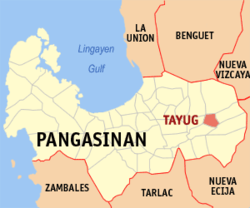Tayug
Appearance
Tayug | |
|---|---|
| Municipality of Tayug | |
 Tayug Welcome Arch | |
 Map of Pangasinan with Tayug highlighted | |
Location within the Philippines | |
| Coordinates: 16°01′36″N 120°44′52″E / 16.02667°N 120.74778°E | |
| Country | |
| Region | Ilocos Region |
| Province | Pangasinan |
| District | 6th district |
| Founded | March 17, 1817 |
| Barangays | 21 (see Barangays) |
| Government | |
| • Type | Sangguniang Bayan |
| • Mayor | Carlos Trece R. Mapili |
| • Vice Mayor | Lorna P. Tacdol |
| • Congressman | Tyrone D. Agabas |
| • Electorate | 29,526 voters (2022) |
| Area | |
| • Total | 51.24 km2 (19.78 sq mi) |
| Elevation | 59 m (194 ft) |
| Population (2020 census)[4] | |
| • Total | 45,241 |
| • Density | 880/km2 (2,300/sq mi) |
| • Households | 12,184 |
| Economy | |
| • Income class | 3rd municipal income class |
| • Poverty incidence | 11.31% (2015)[5] |
| • Revenue (₱) | ₱ 183.3 million (2020) |
| • Assets (₱) | ₱ 257.2 million (2020) |
| • Liabilities (₱) | ₱ 40.65 million (2020) |
| • Expenditure (₱) | ₱ 153.9 million (2020) |
| Time zone | UTC+8 (PST) |
| ZIP code | 2445 |
| PSGC | |
| IDD : area code | +63 (0)75 |
| Native languages | Pangasinan Ilocano Tagalog |
Tayug, officially the Municipality of Tayug (Pangasinan: Baley na Tayug; Ilocano: Ili ti Tayug; Tagalog: Bayan ng Tayug), is a 3rd class municipality in the province of Pangasinan, Philippines. According to the 2020 census, it has a population of 45,241 people.[4]
The town of Tayug got its unique name not from people who were influential or from name of saints but from a very tall tree that once grew in the heart of the town; the bacayao tree was so tall that in Ilocano they call it “Layug”. In view of the difficulty of the people to pronounce the letter “L” they change it to letter “T” by common usage. Hence, the name Tayug came about.
Barangays
Tayug is politically subdivided into 21 barangays.
- Agno
- Amistad
- Barangobong
- Carriedo
- C. Lichauco
- Evangelista
- Guzon
- Lawak
- Legaspi
- Libertad
- Magallanes
- Panganiban
- Barangay Poblacion A
- Barangay Poblacion B
- Barangay Poblacion C
- Barangay Poblacion D
- Saleng
- Santo Domingo
- Toketec
- Trenchera
- Zamora
Climate
| Climate data for Tayug, Pangasinan | |||||||||||||
|---|---|---|---|---|---|---|---|---|---|---|---|---|---|
| Month | Jan | Feb | Mar | Apr | May | Jun | Jul | Aug | Sep | Oct | Nov | Dec | Year |
| Mean daily maximum °C (°F) | 31 (88) |
31 (88) |
32 (90) |
34 (93) |
35 (95) |
34 (93) |
32 (90) |
32 (90) |
32 (90) |
32 (90) |
32 (90) |
31 (88) |
32 (90) |
| Mean daily minimum °C (°F) | 22 (72) |
22 (72) |
22 (72) |
24 (75) |
24 (75) |
24 (75) |
24 (75) |
24 (75) |
24 (75) |
23 (73) |
23 (73) |
22 (72) |
23 (74) |
| Average precipitation mm (inches) | 13.6 (0.54) |
10.4 (0.41) |
18.2 (0.72) |
15.7 (0.62) |
178.4 (7.02) |
227.9 (8.97) |
368 (14.5) |
306.6 (12.07) |
310.6 (12.23) |
215.7 (8.49) |
70.3 (2.77) |
31.1 (1.22) |
1,766.5 (69.56) |
| Average rainy days | 3 | 2 | 2 | 4 | 14 | 16 | 23 | 21 | 24 | 15 | 10 | 6 | 140 |
| Source: World Weather Online[6] | |||||||||||||
Demographics

| Year | Pop. | ±% p.a. |
|---|---|---|
| 1903 | 10,400 | — |
| 1918 | 13,594 | +1.80% |
| 1939 | 16,222 | +0.85% |
| 1948 | 19,782 | +2.23% |
| 1960 | 20,755 | +0.40% |
| 1970 | 24,143 | +1.52% |
| 1975 | 26,153 | +1.62% |
| 1980 | 26,273 | +0.09% |
| 1990 | 31,575 | +1.86% |
| 1995 | 33,881 | +1.33% |
| 2000 | 36,199 | +1.43% |
| 2007 | 37,954 | +0.66% |
| 2010 | 40,018 | +1.95% |
| 2015 | 43,149 | +1.45% |
| Source: Philippine Statistics Authority[7][8][9][10] | ||
References
- ^ Municipality of Tayug | (DILG)
- ^ "Province: Pangasinan". PSGC Interactive. Quezon City, Philippines: Philippine Statistics Authority. Retrieved 12 November 2016.
- ^ https://elevation.maplogs.com/poi/tayug_pangasinan_philippines.239698.html.
{{cite web}}: Missing or empty|title=(help) - ^ a b Census of Population (2020). "Region I (Ilocos Region)". Total Population by Province, City, Municipality and Barangay. Philippine Statistics Authority. Retrieved 8 July 2021.
- ^ "PSA releases the 2015 Municipal and City Level Poverty Estimates". Quezon City, Philippines. Retrieved 1 January 2020.
- ^ "Tayug, Pangasinan: Average Temperatures and Rainfall". World Weather Online. Retrieved 31 October 2015.
- ^ Census of Population (2015). "Region I (Ilocos Region)". Total Population by Province, City, Municipality and Barangay. Philippine Statistics Authority. Retrieved 20 June 2016.
- ^ Census of Population and Housing (2010). "Region I (Ilocos Region)" (PDF). Total Population by Province, City, Municipality and Barangay. National Statistics Office. Retrieved 29 June 2016.
- ^ Censuses of Population (1903–2007). "Region I (Ilocos Region)". Table 1. Population Enumerated in Various Censuses by Province/Highly Urbanized City: 1903 to 2007. National Statistics Office.
{{cite encyclopedia}}: CS1 maint: numeric names: authors list (link) - ^ "Province of Pangasinan". Municipality Population Data. Local Water Utilities Administration Research Division. Retrieved 17 December 2016.
External links
Wikimedia Commons has media related to Tayug.



